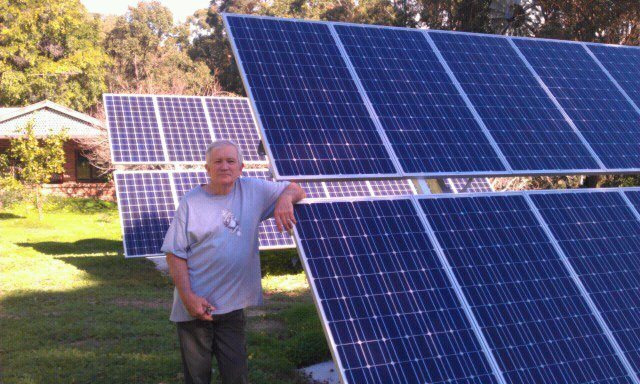
 Peter Holland is used to the spotlight. In a career with the Australian Broadcasting Corporation in TV and radio spanning more than 30 years, Peter finished his career with the ABC as the instantly recognizable face and voice of the nightly news in Western Australia.
Peter Holland is used to the spotlight. In a career with the Australian Broadcasting Corporation in TV and radio spanning more than 30 years, Peter finished his career with the ABC as the instantly recognizable face and voice of the nightly news in Western Australia.
It shouldn’t come as any surprise then that when it came to his home life, he wanted to get away from the glare of media notoriety.
Peter’s home is nestled within thick bushland, and after purchasing the property in the 1960s, the state government made the area around his house a protected forest, meaning he won’t have any neighbors other than kangaroos any time soon.
But it also brought with it challenges as Peter is forced to live off the grid.
Over the years, Peter has enquired about having his home connected to the electricity network, but each time he received a quotation reaching in to the many tens-of-thousands of dollars. This resulted in Peter and his family relying on a noisy, polluting and not terribly efficient diesel generator to supply electricity. While the sound of the Australian bush is one of nature, wildlife and peace, unfortunately the rattle and hum of the generator was the most common sound at Peter’s property.
That was until 2012, when encouraged by the rapidly falling cost of solar panels, Peter installed a six kilowatt-peak ground mounted solar array, comprised of 32 solar panels – in two arrays of 16 – supplied by Suntech. This is connected to a battery system, via two SMA solar inverters.
While the promise of the system was that it would reduce Peter’s reliance on his backup generating, saving big fuel costs and C02 emissions, it actually ended up not being the case. The system’s downfall was the battery system.
Getting the right battery
 “The PV system installed in 2012 was 24 volt, based on the existing lead acid batteries, however this proved inadequate to our requirements resulting in high reliance on the backup diesel generators. It also placed a heavy burden on the batteries,” explains Peter Holland. “As a result, in 2014, the system was upgraded to 48 volts. A new inverter and lithium ion batteries were installed. This added to the overall cost of the system but its performance is now satisfactory.”
“The PV system installed in 2012 was 24 volt, based on the existing lead acid batteries, however this proved inadequate to our requirements resulting in high reliance on the backup diesel generators. It also placed a heavy burden on the batteries,” explains Peter Holland. “As a result, in 2014, the system was upgraded to 48 volts. A new inverter and lithium ion batteries were installed. This added to the overall cost of the system but its performance is now satisfactory.”
While previously, with the 24V lead-acid battery system, Peter had to run his diesel generator almost as frequently as he had to before the solar was installed. The 24V system and lead-acid batteries were just not up to the job.
By contrast, once the lithium ion battery array was installed, Peter has found that frequent use of the diesel generator is a thing of the past.

Photo: Peter Holland
“When the system was upgraded, it immediately commenced performing as I had expected. During the summer months. the generator only started up once, for a scheduled run to ensure it remained in working order,” says Peter.
“During the winter months, with frequent cloud cover reducing the effectiveness of PV collection, I monitor the state of charge of the lithium ion batteries and, if necessary, run the generator for one hour in the evening to ensure enough charge to last until the sun rises in the morning.”
Not cheap
Lithium ion batteries are still an expensive technology and Peter notes that if they last as has been promised, then it will increase the ‘value’ of the entire system. Since installation, however, they and the PV system has required almost zero maintenance – a major difference to a diesel gen set.
“Systems like mine are very expensive and only appropriate when access to the grid is not available. However, once the initial heavy investment is made, the ongoing costs are minimal – as long as the lithium ion batteries live up to the promise of an extended lifetime,” says Peter.

Photo: Peter Holland
Peter and his wife Rosemary can now enjoy the sounds of the wind through the giant eucalypt trees that are scattered around his home, and the native Australian birds rather than the constant growl of the generator. However the process of getting the battery storage right was a difficult one and the initial capital outlay for the lithium ion battery bank significant. Peter is hoping a battery control system, currently being developed by a local company, may assist with preserving the life of the lithium ion batteries and deliver more efficiency to his system.
For someone with a strong profile in the community, Peter’s experience of living with solar+storage is one that could potentially influence others in Western Australia. “Unfortunately it is one with mixed outcomes, largely as a result in the mistaken belief, of the company that initially installed the solar, that the lead acid storage solution would be adequate.”
It’s a mixed message from the Australian bush: the process has not been easy nor cheap, but once PV and batteries work well together, peace of mind and a peaceful environment can be the result.
Jonathan Gifford is a former W.A.-based journalist, and is now the Berlin-based editor of PV-Mag and an occasional contributor to RenewEconomy and One Step Off the Grid.


